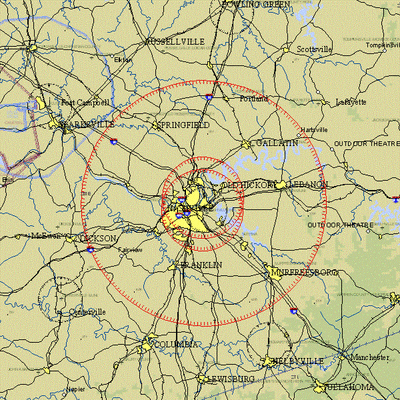Wed, Feb 01, 2006
 NOTAM Number : FDC 6/1184
NOTAM Number : FDC 6/1184
Issue Date : January 31, 2006 at 13:15 UTC
Location : Nashville, Tennessee
Beginning Date and Time : February 01, 2006 at 17:00 UTC
Ending Date and Time : February 01, 2006 at 19:30 UTC
Reason for NOTAM : Temporary flight restrictions for VIP (Very
Important Person) Movement
Type : VIP
Replaced NOTAM(s) : N/A
Affected Area(s)
Area A
Airspace Definition:
TFR Center: 1.8 nautical miles from NASHVILLE VORTAC(BNA) on the
000 radial (Latitude: 36�10'02"N, Longitude:
86�41'12"W)
Radius: 30 nautical miles
Altitude: From the surface up to but not including FL(180)
Effective Date(s):
February 01, 2006 at 17:00 UTC (February 01, 2006 at 11:00 CST) -
February 01, 2006 at 19:30 UTC (February 01, 2006 at 13:30
CST)
Area B
Airspace Definition:
TFR Center: 0.7 nautical miles from NASHVILLE VORTAC(BNA) on the
288 radial (Latitude: 36�08'25"N, Longitude:
86�41'54"W)
Radius: 10 nautical miles
Altitude: From the surface up to but not including FL(180)
Effective Date(s):
February 01, 2006 at 17:00 UTC (February 01, 2006 at 11:00 CST) -
February 01, 2006 at 18:05 UTC (February 01, 2006 at 12:05
CST)
Area C
Airspace Definition:
TFR Center: 3.2 nautical miles from NASHVILLE VORTAC(BNA) on the
000 radial (Latitude: 36�11'24"N, Longitude:
86�41'17"W)
Radius: 10 nautical miles
Altitude: From the surface up to but not including FL(180)
Effective Date(s):
February 01, 2006 at 17:15 UTC (February 01, 2006 at 11:15 CST) -
February 01, 2006 at 19:15 UTC (February 01, 2006 at 13:15
CST)
Area D
Airspace Definition:
TFR Center: 0.7 nautical miles from NASHVILLE VORTAC(BNA) on the
288 radial (Latitude: 36�08'25"N, Longitude:
86�41'54"W)
Radius: 10 nautical miles
Altitude: From the surface up to but not including FL(180)
Effective Date(s):
February 01, 2006 at 18:25 UTC (February 01, 2006 at 12:25 CST) -
February 01, 2006 at 19:30 UTC (February 01, 2006 at 13:30 CST)

Operating Restrictions and Requirements
No pilots may operate an aircraft in the areas covered by this
NOTAM (except as described).
Except as specified below and/or unless authorized by the air
traffic security coordinator via the Domestic Events Network
(DEN):
A. All aircraft operations within a 10 NMR area listed above are
prohibited except for:
1. Approved law enforcement, military aircraft directly supporting
the United States Secret Service (USSS) and the Office of the
President of the United States, approved emergency medical flights,
and regularly scheduled commercial passenger and all-cargo carriers
operating under one of the following TSA-Approved standard security
programs/procedures: aircraft operator standard security program
(AOSSP), domestic security integration program (DSIP), twelve five
standard security program (TFSSP), or all-cargo international
security procedure (ACISP) and are arriving into and/or departing
from 14 CFR part 139 airports.
2. For operations within the TFR, all approved medical flight
operation companies must coordinate operations in advance with the
USSS at 615-399-5158 to avoid potential delays.
B. Within the airspace between 10 NMR and 30 NMR listed
above:
1. All aircraft entering or exiting the 30 NM radius TFR must be on
an active IFR or VFR flight plan with a discrete code assigned by
an Air Traffic Control (ATC) facility. Aircraft must be squawking
the discrete code prior to departure and at all times while in the
TFR.
2. All aircraft entering or exiting the 30 NM radius TFR must
remain in two-way radio communications with ATC.
3. All aircraft operating within the 10 to 30 NM radius TFR and
operating at altitudes of up to but not including FL180 are limited
to aircraft arriving or departing local airfields and ATC may
authorize transit operations. Aircraft may not loiter.
4. Flight training, practice instrument approaches, aerobatic
flight, glider operations, parachute operations, ultralight, hang
gliding, balloon operations, agriculture/crop dusting, animal
population control flight operations, and banner towing operations
are not authorized.
5. All USSS cleared aircraft operators based in the area should
notify the USSS prior to their departure.
6. For operations within the TFR, all approved medical flight
operation companies must coordinate operations in advance with the
USSS at 615-399-5158 to avoid potential delays.
C. FAA recommends that all aircraft operators check NOTAMS
frequently for possible changes to this TFR prior to operations
within this region.
Other Information:
ARTCC: ZME - Memphis Center
Authority: Title 14 CFR section 91.141
FMI: www.tfr.faa.gov,
Depicted TFR data may not be a complete listing. Pilots should not
use the information on this website for flight planning purposes.
For the latest information call your local FSS at
1-800-WX-BRIEF
More News
“While legendary World War II aircraft such as the Corsair and P-51 Mustang still were widely flown at the start of the Korean War in 1950, a new age of jets rapidly came to >[...]
Decision Altitude (DA) A specified altitude (mean sea level (MSL)) on an instrument approach procedure (ILS, GLS, vertically guided RNAV) at which the pilot must decide whether to >[...]
Aero Linx: National Aviation Safety Foundation (NASF) The National Aviation Safety Foundation is a support group whose objective is to enhance aviation safety through educational p>[...]
Also: Cal Poly Aviation Club, $$un Country, Arkansas Aviation Academy, Teamsters Local 2118 In response to two recent general aviation accidents that made national headlines, more >[...]
“The FAA is tasked with ensuring our skies are safe, and they do a great job at it, but there is something about the system that is holding up the medical process. Obviously,>[...]
 Aero-News: Quote of the Day (04.28.25)
Aero-News: Quote of the Day (04.28.25) ANN's Daily Aero-Term (04.28.25): Decision Altitude (DA)
ANN's Daily Aero-Term (04.28.25): Decision Altitude (DA) ANN's Daily Aero-Linx (04.28.25)
ANN's Daily Aero-Linx (04.28.25) Airborne-Flight Training 04.24.25: GA Refocused, Seminole/Epic, WestJet v TFWP
Airborne-Flight Training 04.24.25: GA Refocused, Seminole/Epic, WestJet v TFWP Aero-News: Quote of the Day (04.29.25)
Aero-News: Quote of the Day (04.29.25)




